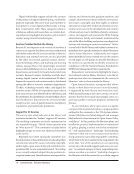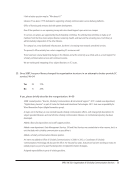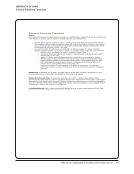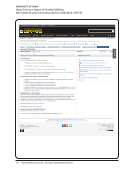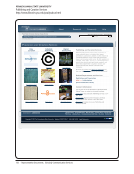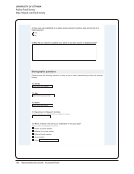16 · Survey Results: Executive Summary
for certification as a Trusted Digital Repository, a
program offered in conjunction with the National
Archives and Records Administration, OCLC, and
the Research Libraries Group.
At those libraries that have conducted assessment,
one has used the data gathered to better inform li-
aison work by recognizing differences in SC needs,
and approaches to SC, among various disciplines.
Another library, using results from their institution’s
SC survey, has plans to “investigate implementing
new services for OA monograph publishing, print
on demand, and [to] improve digital preservation.”
Redesigning the library’s SC-related web pages was
a priority for one recent assessment project. Finally,
several assessment projects aim to survey local trends
in SC issues, such as faculty awareness of open ac-
cess policies, interest in particular SC educational
programs, and research data needs, to better plan the
library’s future SC outreach and technology-related
support.
Impact on Authors
The survey asked respondents to identify, from a list,
which demonstrable outcomes have resulted from
their library’s or institution’s SC efforts and services.
If the prompt had been to “indicate which outcomes
might have resulted, at least in part, from the SC ef-
forts and services your library or institution provides,”
the answers might have been different. Instead, one
commenter stated, “I do not feel comfortable in an-
swering this question as I have no way of knowing if
authors have changed their practices based solely on
the SC efforts we have done,” and another offered, “It
is my opinion that because we have not engaged in
formal assessment, it’s difficult or impossible to de-
termine whether the libraries’ SC efforts and services
have had demonstrable outcomes.”
Nevertheless, a majority of respondents provided
feedback on how authors participate in SC activities
and how institutions support those activities or con-
sider new directions in SC policies. The most common
outcomes reported were authors submitting work to
the institutional repository (80%), seeking assistance
with questions related to authorship, which have in-
creased since 2007 (65%), and authors complying with
funding mandates from agencies such as NIH and
NSF (59%). Forty-three percent reported that authors
at their institutions have used Creative Commons/
Scholars Commons licenses for their work, and 20
institutions (41%) indicated that authors have increas-
ingly published in open access journals. Other out-
comes include authors using copyright addenda (35%),
submitting work to subject or disciplinary repositories
(31%), and declining to publish in or edit particular
journals (27%).
The number of institutions reporting that faculty
have declined to publish in or edit particular journals
was supplemented in the comments by responses
referring to faculty and student activism, such as
signing the “recent White House petition” on open
access and the “’Cost of Knowledge’ [Elsevier] boy-
cott.” In these comments, more than one respondent
again noted that faculty editors are founding open
access journals, often using the library-hosted, Public
Knowledge Project-developed Open Journal Systems
platform. Also included in the comments was the
fact that librarians at one institution had themselves
adopted an open access resolution.
Impact on Institutions
The respondents’ most commonly identified institu-
tional impacts were an increased use of the institu-
tional repository, a growing interest in and support
for open access publishing, and growing numbers of
staffing and/or physical spaces to handle SC-related
responsibilities. The vast majority host an institutional
repository (44, or 82%) and most of those repositories
have seen an increase in holdings (39, or 70%). Related
to this finding, electronic theses and dissertations are
available open access at 44 institutions. Furthermore,
as noted above, 20 institutions have seen an increas-
ing number of faculty publishing in OA journals and
16 (30%) have created or maintained an open access
publishing fund to support this growth.
Organizational changes also reflect the increas-
ing importance of SC issues to institutions. Most re-
spondents have seen the number of positions with
SC responsibilities at their institutions increase since
2007 (38, or 70%), 13 (24%) have created new centers or
institutes to deal solely with SC questions and sup-
port, and 11 (20%) have rearranged or gained physical
spaces to better support SC services.
for certification as a Trusted Digital Repository, a
program offered in conjunction with the National
Archives and Records Administration, OCLC, and
the Research Libraries Group.
At those libraries that have conducted assessment,
one has used the data gathered to better inform li-
aison work by recognizing differences in SC needs,
and approaches to SC, among various disciplines.
Another library, using results from their institution’s
SC survey, has plans to “investigate implementing
new services for OA monograph publishing, print
on demand, and [to] improve digital preservation.”
Redesigning the library’s SC-related web pages was
a priority for one recent assessment project. Finally,
several assessment projects aim to survey local trends
in SC issues, such as faculty awareness of open ac-
cess policies, interest in particular SC educational
programs, and research data needs, to better plan the
library’s future SC outreach and technology-related
support.
Impact on Authors
The survey asked respondents to identify, from a list,
which demonstrable outcomes have resulted from
their library’s or institution’s SC efforts and services.
If the prompt had been to “indicate which outcomes
might have resulted, at least in part, from the SC ef-
forts and services your library or institution provides,”
the answers might have been different. Instead, one
commenter stated, “I do not feel comfortable in an-
swering this question as I have no way of knowing if
authors have changed their practices based solely on
the SC efforts we have done,” and another offered, “It
is my opinion that because we have not engaged in
formal assessment, it’s difficult or impossible to de-
termine whether the libraries’ SC efforts and services
have had demonstrable outcomes.”
Nevertheless, a majority of respondents provided
feedback on how authors participate in SC activities
and how institutions support those activities or con-
sider new directions in SC policies. The most common
outcomes reported were authors submitting work to
the institutional repository (80%), seeking assistance
with questions related to authorship, which have in-
creased since 2007 (65%), and authors complying with
funding mandates from agencies such as NIH and
NSF (59%). Forty-three percent reported that authors
at their institutions have used Creative Commons/
Scholars Commons licenses for their work, and 20
institutions (41%) indicated that authors have increas-
ingly published in open access journals. Other out-
comes include authors using copyright addenda (35%),
submitting work to subject or disciplinary repositories
(31%), and declining to publish in or edit particular
journals (27%).
The number of institutions reporting that faculty
have declined to publish in or edit particular journals
was supplemented in the comments by responses
referring to faculty and student activism, such as
signing the “recent White House petition” on open
access and the “’Cost of Knowledge’ [Elsevier] boy-
cott.” In these comments, more than one respondent
again noted that faculty editors are founding open
access journals, often using the library-hosted, Public
Knowledge Project-developed Open Journal Systems
platform. Also included in the comments was the
fact that librarians at one institution had themselves
adopted an open access resolution.
Impact on Institutions
The respondents’ most commonly identified institu-
tional impacts were an increased use of the institu-
tional repository, a growing interest in and support
for open access publishing, and growing numbers of
staffing and/or physical spaces to handle SC-related
responsibilities. The vast majority host an institutional
repository (44, or 82%) and most of those repositories
have seen an increase in holdings (39, or 70%). Related
to this finding, electronic theses and dissertations are
available open access at 44 institutions. Furthermore,
as noted above, 20 institutions have seen an increas-
ing number of faculty publishing in OA journals and
16 (30%) have created or maintained an open access
publishing fund to support this growth.
Organizational changes also reflect the increas-
ing importance of SC issues to institutions. Most re-
spondents have seen the number of positions with
SC responsibilities at their institutions increase since
2007 (38, or 70%), 13 (24%) have created new centers or
institutes to deal solely with SC questions and sup-
port, and 11 (20%) have rearranged or gained physical
spaces to better support SC services.














